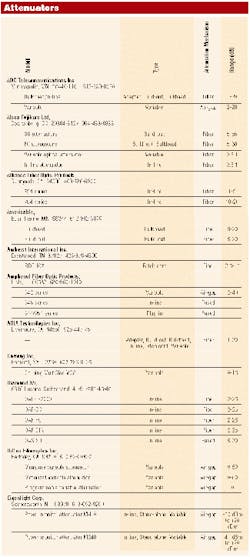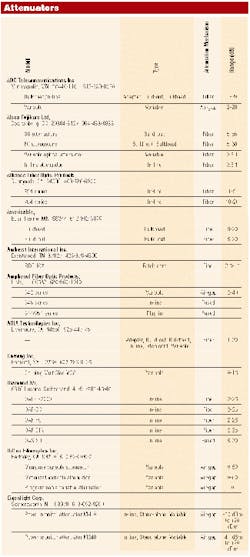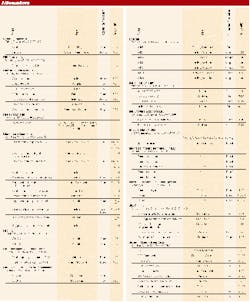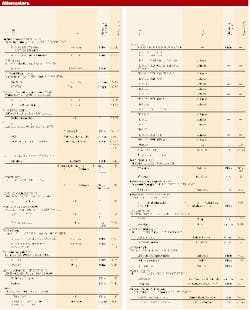Attenuators evolving with all-optical network architectures
The role of an attenuator, in the most general sense, is to reduce the power level of an optical signal being transmitted through an optical fiber. Compared to other equipment making up the optical network, these devices may not be considered sophisticated components, but they still play an important role in optical transmissions.
Generally, attenuation represents one of the limiting factors in optical networks. Network designers compensate for this effect through the use of optical-amplification devices such as erbium-doped fiber amplifiers (EDFAs), according to Erica Henkel, a consulting analyst on optical networking at Frost & Sullivan, an industry analyst firm based in Mountain View, CA. "Occasionally, when an amplifier is required in a network span, the amount of gain [increase in power] created is too much for the distance the signal is required to travel," says Henkel. "In these instances, attenuators are installed in the network in order to reduce the amount of gain introduced by the amplifier."
For example, an attenuator is often used in conjunction with an EDFA in applications where the boost in power is too great for the photodetector on the receive end. The attenuator protects the receiver from being flooded by too strong a signal, which would increase the bit error rate.
Attenuators come in several flavors, but most fall into one of two main categories: fixed or variable. Fixed attenuators can be either bulkhead adapter style for rapid and convenient mounting when optical power reduction is necessary or a patch cord type installed in a patch cord or splice tray. Variable attenuators are used in networks where stocking and tracking of fixed attenuators is difficult. Other categories further differentiate variable attenuators ac cording to how they are adjusted. For example, there are attenuators that are electronically controllable or programmable.
The need to manage optical power in a multinode, multiwavelength, and multiservice environment from path-to-path or wavelength-to-wavelength applications has enabled attenuator devices to come into their own.
"Attenuators are a relatively new development in the evolution of fiber-optic systems," says Rob Sullivan, business development manager at Johanson Manu facturing Corp. (Boonton, NJ). "After decades of developing higher-powered sources and lower-loss components, attenuators have only recently become an important photonic component. First used to bring optical power levels down into the dynamic range of receivers used in short-distance applications, attenuators are now used in conjunction with amplifiers to provide the system designer with a means to 'manage' optical power. This becomes increasingly important as optical fiber moves from point-to-point links into multinode network infrastructures."
The current market for attenuator devices appears to be healthy enough. As emerging applications continue to be driven by the all-optical network push throughout the fiber-optic telecommunications community, the opportunity exists for vendors to showcase new attenuator products. According to vendors, these new products should continue to provide growth opportunity in revenue and unit volumes.
"I view the attenuator market as young and very healthy," says Sullivan. "Pricing is very competitive and the price curve has been dropping steeply the past few years. Fixed attenuators have matured and represent the largest unit volume potential. Pricing should be leveling out, if not already flat."
Pierre Leonard, product line manager at JDS Uniphase Inc. (Nepean, ON) agrees that today's attenuator market is showing respectable growth, mainly due to the optical component and systems market.
"Market demand for WDM [wavelength-division multiplexing] components, such as EDFAs and 10-Gbit/sec optical systems manufacturing is fueling much of this demand for the various types of optical attenuators," says Leonard.
The market is indeed experiencing a growth spurt according to a report compiled by ElectroniCast Corp., a San Mateo, CA-based industry analysis firm. In the report, ElectroniCast forecasts an increase in component optical-attenuator consumption averaging 22.5% per year, reaching more than $498 million by 2003. Continued expansion is expected to reach $1.45 billion by 2008. The largest consumption in 1998 was electronically controlled variable-optical attenuators.
"Variable attenuators are ideal for simulating cable loss for research and development testing of optical communication-link power limits or reducing power in the links where receivers are in the process of being overloaded," says Montgomery. "Fixed in-line attenuators can distinguish the color-band coding process to simplify the specification identification of the optical communication-link components during field installation, stocking, or maintenance operations."
According to ElectroniCast, pigtailed (cable assembly/jumper) fiber-optic attenuator consumption value will increase at an average annual growth rate of 10.3% from 1998 through 2003. Fixed panel-mount fiber-optic attenuator consumption value is similar to the jumper type. Panel-mount attenuators will increase at an average growth rate of 12.2% over the same period.
There are trends developing in the attenuator market that have manufacturers working overtime to fulfill the requirements of customers seeking solutions to controlling optical levels. JDS Uniphase's Leonard points to fiber-optic amplifiers incorporated in WDM optical networks as a major driver that is forcing network designers to find new ways for testing, controlling, and dynamically reconfiguring optical levels.
"Optical attenuators are proving to be a valuable tool," says Leonard. "Major characteristics demanded by lab and manufacturing customers are accuracy, repeatability, polarization insensitivity, and wavelength flat output. We're addressing all of these issues in our products."
Johanson's Sullivan also sees the use of WDM techniques in optical-network applications as a significant trend for attenuator manufacturers. Component costs, he says, need to drop significantly to continue the move of fiber into optical-networking applications.
"The ability to amplify and attenuate optical power will allow relaxation of port-to-port uniformity requirements, thereby reducing component cost while broadening applications possibilities," says Sullivan. "Attenuators are also moving from the fixed to the dynamically variable type. Fixed are essentially mature and will continue to see significant consumption, but the ability to dynamically adjust attenuation, either manually or automatically, is desirable in the emerging applications."
At ADC Telecommunications Inc. (Minneapolis, MN) a similar trend is being observed. Ultimately, ADC believes attenuators will depart from being fixed pieces with a set attenuation to actively addressable devices. The customer will be able to buy one device that can be placed anywhere at anytime within a network and set remotely, as needed.
"In fact, the ability to be used variably, say on one side of an optical switch to balance signal power, or even to be used as a variable 'color' or wavelength-selective attenuation component, would seem to be a natural progression," says Pete Fettig, product manager at ADC. "It's also a device that would be a significant value-added component or integrated module. I believe the attenuator market is on a path to other pieces of component developments or integrated modules."


